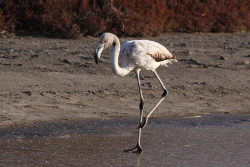The cold wave that gripped Europe from 1 to 13 February killed many waterbirds in the PACA and Languedoc-Roussillon Regions. The Greater flamingo, which is the flagship species in the Camargue, was closely monitored. Fortunately, the results of our Flamingo team’s operation for picking up victims proved reassuring: although there were a significant number of deaths, the Greater flamingo population is not endangered.
 Although temperatures were not as low as the exceptional winter of 1985, the surface area of frozen water attained the same proportions, raising serious concerns. In 1985, some 6600 flamingos froze to death and entire waterbird populations were threatened with extinction.
Although temperatures were not as low as the exceptional winter of 1985, the surface area of frozen water attained the same proportions, raising serious concerns. In 1985, some 6600 flamingos froze to death and entire waterbird populations were threatened with extinction.
During the recent cold snap, many exhausted flamingos were picked up and cared for in special centres, particularly at the Pont de Gau Ornithological Park. Many others could not be taken in, and froze to death. In order to monitor the impact of the exceptional cold, the Tour du Valat called on all lagoon area managers to pick up the carcasses of flamingos and other large waterbirds. Nearly 800 Greater flamingo corpses were counted in the PACA and Languedoc-Roussillon Regions, with 25% of them in the Camargue. Measurements were made on 200 flamingo carcasses to analyse parameters such as age structure, biometrics and body condition, which are hard to measure in these wild birds under normal conditions. In spite of this exceptional mortality rate, the Greater flamingos of the Camargue are not in danger.